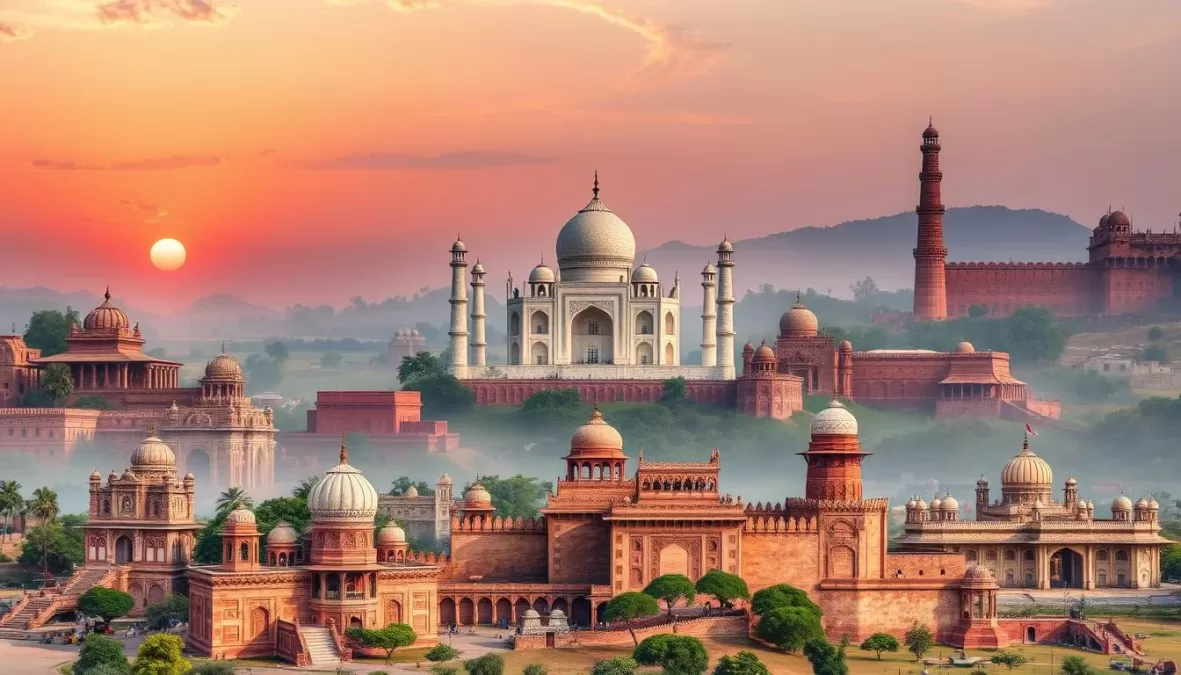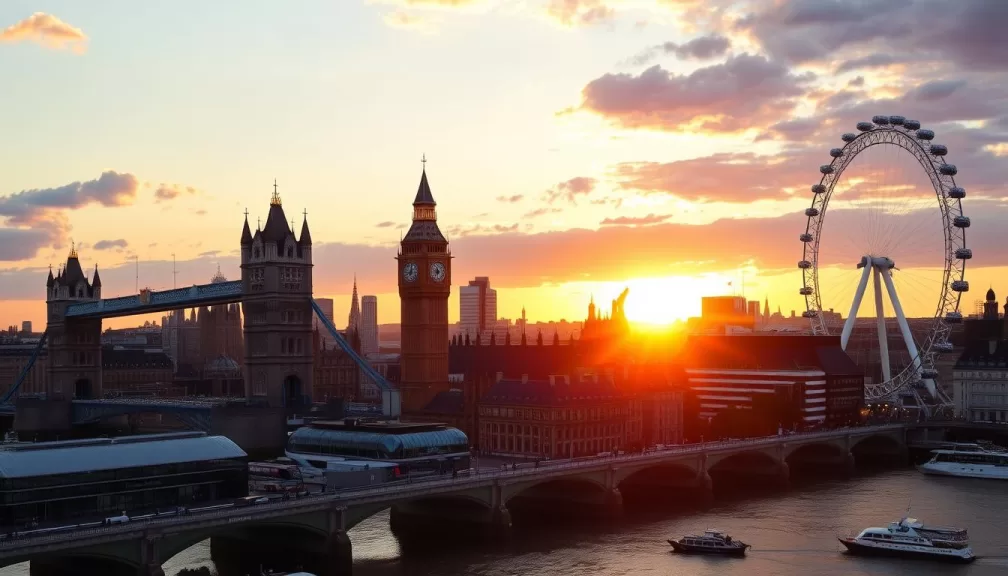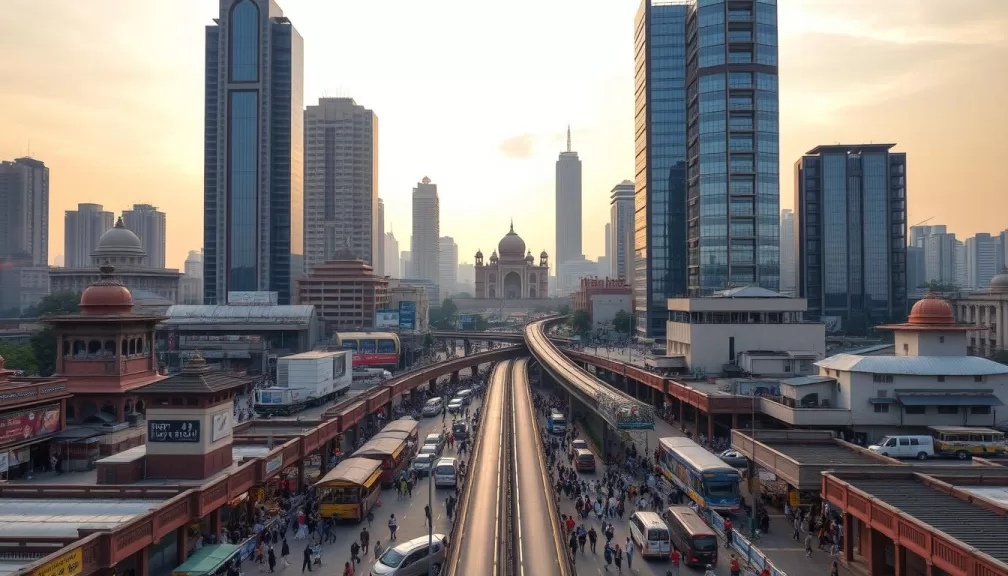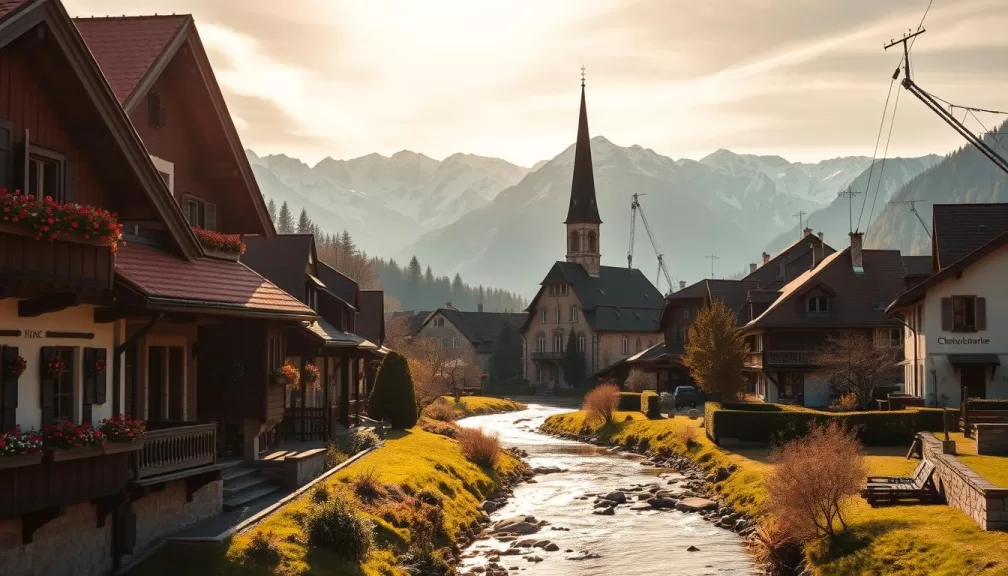India’s history, over 5,000 years long, has left us with amazing ancient monuments and architectural wonders. These sites, from the Taj Mahal’s beauty to the Red Fort’s grandeur, show us the nation’s rich culture. They leave a lasting impression on everyone who visits.
Exploring India’s top 10 historical places takes you on a deep cultural journey. You’ll see the past’s architectural brilliance and understand India’s remarkable history. These UNESCO World Heritage Sites and famous landmarks are not just beautiful. They take you back in time, connecting you with India’s incredible history.
Key Takeaways
- India’s rich 5,000-year history has left behind a vast array of captivating historical places.
- Exploring the top 10 historical sites in India offers a profound cultural experience.
- These renowned landmarks, many of which are UNESCO World Heritage Sites, reflect the country’s diverse architectural and cultural heritage.
- Visiting these iconic landmarks promises to deepen your appreciation for India’s remarkable legacy.
- Embarking on a journey through India’s top historical places is a must for any traveler seeking to immerse themselves in the nation’s storied past.
Magnificent Taj Mahal in Agra
The Taj Mahal is a stunning work of architecture that has amazed people for over 300 years. It stands by the Yamuna River in Agra. The Mughal emperor Shah Jahan built it in the 17th century to honor his wife, Mumtaz Mahal. It’s made entirely of white marble, showing the Mughals’ skill and the lasting power of love.
Ethereal Beauty in White Marble
The Taj Mahal’s beauty comes from its detailed design and craftsmanship. It’s covered in delicate carvings and inlays of precious stones. These make it seem to shimmer in the sunlight. Its symmetrical design and elegant domes bring peace and harmony, making it a masterpiece.
As a UNESCO World Heritage Site, the Taj Mahal is seen as the top achievement in Mughal architecture. Its beauty and importance have made it a famous historical spot in India. Every year, millions of people from all over the world visit it.
“The Taj Mahal is the most beautiful monument of love in the world, and one of the most recognizable symbols of India’s cultural heritage.”
Formidable Agra Fort
In the heart of Agra, the Agra Fort is a symbol of Mughal architecture’s grandeur. Built in the 16th century, it was the main home of many Mughal rulers, including the famous Emperor Akbar. It’s made mostly of red sandstone.
The fort’s high walls and grand buildings mix Hindu and Islamic styles. You’ll see beautiful carvings, domes, and arches. These make the fort a stunning and important place to visit.
The Agra Fort is a UNESCO World Heritage Site. It lets visitors see the Mughal Empire’s rich history and culture. You can see places like the Jahangir’s Palace, the Khas Mahal, and the Diwan-i-Khas. Each has its own special design and stories.
Located by the Yamuna River, the fort was key to Mughal rule. It’s a top spot for those who love history and architecture. The Agra Fort still amazes people from all over the world.

| Fact | Detail |
|---|---|
| Construction | The Agra Fort was built in the 16th century during the reign of Mughal emperor Akbar. |
| Materials | The fort is constructed primarily from red sandstone, a hallmark of Mughal architecture. |
| UNESCO Status | The Agra Fort is a UNESCO World Heritage Site, recognized for its cultural and historical significance. |
| Architectural Style | The fort showcases a harmonious blend of Hindu and Islamic architectural styles, with intricate carvings and elegant domes. |
| Significance | The Agra Fort served as the primary residence of several Mughal rulers, including the renowned Emperor Akbar. |
Imposing Red Fort in Delhi
The Red Fort in Delhi is a symbol of Mughal grandeur. It was built by Shah Jahan in the 17th century. The fort is made of red sandstone and has walls, gardens, and halls that amaze visitors.
The fort’s design is stunning, with balconies and decorations that show its royal beauty. It’s a UNESCO World Heritage Site, attracting people from all over to see its beauty.
Iconic Symbol of Mughal Grandeur
The Red Fort shows the power of the Mughal dynasty. Its long red sandstone walls show the skill of Mughal architects.
Inside, you can see many historical spots. There’s the Diwan-i-Am, Diwan-i-Khas, and Rang Mahal. Each place gives a peek into the Mughal lifestyle.

“The Red Fort stands as a testament to the architectural and engineering genius of the Mughal Empire, showcasing the very best of Indian craftsmanship and design.”
The Red Fort is a UNESCO World Heritage Site. It draws visitors worldwide, showing its lasting Mughal legacy and its place among India’s top historical sites.
Top 10 Historical Places in India
India’s history is filled with amazing places that draw visitors from all over. The Taj Mahal, Agra Fort, and Red Fort in Delhi are just a few examples. They show off India’s rich culture and stunning architecture.
Other famous spots include the Qutub Minar, Fatehpur Sikri, Hawa Mahal, Victoria Memorial, and Humayun’s Tomb. Each place has its own story, adding to India’s rich history and culture.
These sites are known as UNESCO World Heritage Sites. They prove India’s lasting legacy and are perfect for anyone wanting to explore Indian heritage.
| Historical Place | Location | Architectural Style | UNESCO Status |
|---|---|---|---|
| Taj Mahal | Agra | Mughal | World Heritage Site |
| Agra Fort | Agra | Mughal | World Heritage Site |
| Red Fort | Delhi | Mughal | World Heritage Site |
| Qutub Minar | Delhi | Indo-Islamic | World Heritage Site |
| Fatehpur Sikri | Agra | Mughal | World Heritage Site |
These top 10 historical places in India are more than just landmarks. They show off India’s rich culture and architecture. Each site tells a story, making visitors feel like they’ve stepped back in time.

“India is the cradle of the human race, the birthplace of human speech, the mother of history, the grandmother of legend, and the great grandmother of tradition.”
– Mark Twain
Qutub Minar: The Towering Brick Minaret
The Qutub Minar stands tall over Delhi, showing off India’s architectural skill and history. This brick minaret is 72.5 meters high and was built in the late 12th century. It was ordered by Qutb-ud-din-Aibak to celebrate the Muslim victory in Delhi. The minaret’s design, mixing Hindu and Mughal architecture, makes it a UNESCO World Heritage Site. It’s a key spot for anyone wanting to see India’s history.
Architectural Marvel and UNESCO Site
The Qutub Minar’s design shows the skill of its creators. It has five levels, each with beautiful calligraphy and patterns. The mix of Qutub Minar, Delhi, and Mughal architecture is stunning. Visitors can see the contrast of red sandstone and white marble. They can also enjoy great views from the top.

The Qutub Minar is a UNESCO World Heritage Site, showing its big cultural and historical value. This honor means it’s seen as a place of great global importance. It’s saved for people in the future to see the amazing work of Qutb-ud-din-Aibak and others.
“The Qutub Minar is a true architectural gem, a testament to the ingenuity and craftsmanship of its builders. Its soaring presence and intricate details captivate all who visit, making it a must-see destination for any traveler to India.”
Fatehpur Sikri: Architectural Gem of Akbar
In the heart of Uttar Pradesh, Fatehpur Sikri is a gem of the Mughal Empire’s architecture. Founded by Emperor Akbar in the 16th century, it was the Mughal capital for over a decade. It shows the amazing skill and creativity of Mughal design.
The city is made mostly of red sandstone and is a UNESCO World Heritage Site. It amazes visitors with its detailed buildings and stunning beauty. Places like the Jodha Bai’s Palace, Buland Darwaza, and Jama Masjid show the great care in Mughal architecture.
“Fatehpur Sikri is a true masterpiece of Mughal engineering, where every stone tells a story of the empire’s rich history and cultural heritage.”
Walking through Fatehpur Sikri, you feel the past coming alive. You can almost hear the Mughal rulers’ footsteps. This city is a key spot for those who love history and architecture.
Hawa Mahal: The Palace of Winds
In the vibrant city of Jaipur, the Hawa Mahal, or “Palace of Winds,” is a famous landmark. Built in the 18th century, it mixes Rajput and Mughal styles. It has a beautiful pink sandstone facade with over 900 small windows.
The design lets royal ladies watch the streets below without being seen. It also brings in a cool breeze through its detailed latticework. Now, it’s seen as one of Jaipur’s top historical spots.
Jaipur’s Iconic Landmark
The Hawa Mahal shows off Jaipur’s rich culture, combining Rajput and Mughal styles. Its unique look makes it a symbol of the “Pink City.” People from all over come to see its beauty and design.
“The Hawa Mahal is a true masterpiece of Rajput architecture, showcasing the ingenuity and craftsmanship of its builders.”
The Hawa Mahal is more than just pretty. It gives us a peek into the lives of the Rajput royal women. This 18th-century landmark still amazes and inspires everyone who visits.
Victoria Memorial: A Tribute to Queen Victoria
In the heart of Kolkata, the Victoria Memorial stands tall. It honors the British Raj in India. This beautiful white marble building combines European, Medieval, and Islamic architectural styles. It shows off the Indo-Saracenic design of the colonial times.
The Victoria Memorial is set in lovely gardens. Inside, you’ll find art, sculptures, and historical items. They give a peek into India’s colonial past. The building’s details like carvings, domes, and arches make it a sight to behold.
Walking through the Victoria Memorial, you’ll feel awe and respect for Queen Victoria and the British Raj‘s impact. This landmark shows the lasting effect of the colonial era. It’s a reminder of India’s history and the strength of its people.
| Architectural Style | Key Features |
|---|---|
| Indo-Saracenic |
|
| White Marble |
|
The Victoria Memorial is more than a historical site. It’s a symbol of the British Raj‘s legacy and India’s cultural mix. Exploring this place, you’ll be drawn to its ethereal beauty and the stories it shares.
Humayun’s Tomb: The First Garden-Tomb
Humayun’s Tomb sits by the Yamuna River in Delhi. It’s a key monument in Mughal architecture. Built in the 16th century, it was made by Humayun’s wife. It’s the first garden-tomb in the region and a precursor to the famous Taj Mahal.
The tomb is made of red sandstone with white marble details. It has a big, double-storied gateway that opens to a beautiful garden. This mix of architecture and nature makes it a UNESCO World Heritage Site. It’s known for its history and culture.
Architectural Precursor to the Taj Mahal
Humayun’s Tomb is seen as a key step before the Taj Mahal. Its design, using red sandstone and white marble, hints at the Taj Mahal’s features. It’s a pioneering Mughal monument that shows India’s architectural growth.
“Humayun’s Tomb is a true masterpiece of Mughal architecture, a testament to the ingenuity and craftsmanship of its builders. Its enduring legacy continues to captivate and inspire visitors from around the world.”
Conclusion
India’s history and culture shine through its amazing historical places. Each one gives us a peek into the country’s past. The Taj Mahal and the Red Fort show the beauty and strength of India’s history.
Visiting India’s top 10 historical sites takes you on a journey through culture. You’ll see the amazing architecture and learn about India’s lasting legacy. Many of these sites are UNESCO World Heritage Sites, showing their global importance.
At places like the Qutub Minar, Humayun’s Tomb, and the Hawa Mahal, you see India’s culture, art, and heritage. These sites let you travel back in time. They make you appreciate India’s history even more.





